While looking out the window of the International Space Station last Thursday, astronaut Ed Lu noticed a small object floating in space which he described as a rectangular piece of metal about 5 cm long. Fortunately he had a camera handy and snapped a picture so NASA could figure out what had gotten loose from the station. The current theory is that it’s an identification tag from an external power or data cable. NASA officials say it poses no threat to the station because its low relative velocity.
Glimpse Into a Star Factory
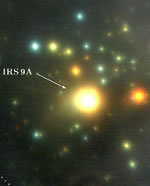
Image credit: ESO
A new series of photographs taken by the European Southern Observatory show a rare look into the very early stages of heavy star formation. This time in a star’s life is usually obscured from sight because of thick clouds of gas and dust, but in star cluster NGC 3603, the stellar wind from hot stars are blasting away the obscuring material. Inside this cluster, astronomers are finding massive protostars which are only 100,000 years old. This is a valuable discovery because it helps astronomers understand how the early stages of heavy star formation begins – is it through gravity pulling together gas and dust, or something more violent, like smaller stars colliding together.
Based on a vast observational effort with different telescopes and instruments, ESO-astronomer Dieter N?rnberger has obtained a first glimpse of the very first stages in the formation of heavy stars.
These critical phases of stellar evolution are normally hidden from the view, because massive protostars are deeply embedded in their native clouds of dust and gas, impenetrable barriers to observations at all but the longest wavelengths. In particular, no visual or infrared observations have yet “caught” nascent heavy stars in the act and little is therefore known so far about the related processes.
Profiting from the cloud-ripping effect of strong stellar winds from adjacent, hot stars in a young stellar cluster at the center of the NGC 3603 complex, several objects located near a giant molecular cloud were found to be bona-fide massive protostars, only about 100,000 years old and still growing.
Three of these objects, designated IRS 9A-C, could be studied in more detail. They are very luminous (IRS 9A is about 100,000 times intrinsically brighter than the Sun), massive (more than 10 times the mass of the Sun) and hot (about 20,000 degrees). They are surrounded by relative cold dust (about 0?C), probably partly arranged in disks around these very young objects.
Two possible scenarios for the formation of massive stars are currently proposed, by accretion of large amounts of circumstellar material or by collision (coalescence) of protostars of intermediate masses. The new observations favour accretion, i.e. the same process that is active during the formation of stars of smaller masses.
How do massive stars form?
This question is easy to pose, but so far very difficult to answer. In fact, the processes that lead to the formation of heavy stars [1] is currently one the most contested areas in stellar astrophysics.
While many details related to the formation and early evolution of low-mass stars like the Sun are now well understood, the basic scenario that leads to the formation of high-mass stars still remains a mystery. It is not even known whether the same characterizing observational criteria used to identify and distinguish the individual stages of young low-mass stars (mainly colours measured at near- and mid-infrared wavelengths) can also be used in the case of massive stars.
Two possible scenarios for the formation of massive stars are currently being studied. In the first, such stars form by accretion of large amounts of circumstellar material; the infall onto the nascent star varies with time. Another possibility is formation by collision (coalescence) of protostars of intermediate masses, increasing the stellar mass in “jumps”.
Both scenarios impose strong limitations on the final mass of the young star. On one side, the accretion process must somehow overcome the outward radiation pressure that builds up, following the ignition of the first nuclear processes (e.g., deuterium/hydrogen burning) in the star’s interior, once the temperature has risen above the critical value near 10 million degrees.
On the other hand, growth by collisions can only be effective in a dense star cluster environment in which a reasonably high probability for close encounters and collisions of stars is guaranteed.
Which of these two possibilties is then the more likely one?
Massive stars are born in seclusion
There are three good reasons that we know so little about the earliest phases of high-mass stars:
First, the formation sites of such stars are in general much more distant (many thousands of light-years) than the sites of low-mass star formation. This means that it is much more difficult to observe details in those areas (lack of angular resolution).
Next, in all stages, also the earliest ones (astronomers here refer to “protostars”), high-mass stars evolve much faster than low-mass stars. It is therefore more difficult to “catch” massive stars in the critical phases of early formation.
And, what is even worse, due to this rapid development, young high-mass protostars are usually very deeply embedded in their natal clouds and therefore not detectable at optical wavelengths during the (short) phase before nuclear reactions start in their interior. There is simply not enough time for the cloud to disperse – when the curtain finally lifts, allowing a view of the new star, it is already past those earliest stages.
Is there a way around these problems? “Yes”, says Dieter N?rnberger of ESO-Santiago, “you just have to look in the right place and remember Bob Dylan…!”. This is what he did.
“The answer, my friend, is blowing by the wind…”
Imagine that it would be possible to blow away most of the obscuring gas and dust around those high-mass protostars! Even the strongest desire of the astronomers cannot do it, but there are fortunately others who are better at it!
Some high-mass stars form in the neighbourhood of clusters of hot stars, i.e., next to their elder brethren. Such already evolved hot stars are a rich source of energetic photons and produce powerful stellar winds of elementary particles (like the “solar wind” but many times stronger) which impact on the surrounding interstellar gas and dust clouds. This process may lead to partial evaporation and dispersion of those clouds, thereby “lifting the curtain” and letting us look directly at young stars in that region, also comparatively massive ones at a relatively early evolutionary stage.
The NGC 3603 region
Such premises are available within the NGC 3603 stellar cluster and star-forming region that is located at a distance of about 22,000 light-years in the Carina spiral arm of the Milky Way galaxy.
NGC 3603 is one of the most luminous, optically visible “HII-regions” (i.e. regions of ionized hydrogen – pronounced “eitch-two”) in our galaxy. At its centre is a massive cluster of young, hot and massive stars (of the “OB-type”) – this is the highest density of evolved (but still relatively young) high-mass stars known in the Milky Way, cf. ESO PR 16/99.
These hot stars have a significant impact on the surrounding gas and dust. They deliver a huge amount of energetic photons that ionize the interstellar gas in this area. Moreover, fast stellar winds with speeds up to several hundreds of km/sec impact on, compress and/or disperse adjacent dense clouds, referred to by astronomers as “molecular clumps” because of their content of complex molecules, many of these “organic” (with carbon atoms).
IRS 9: a “hidden” association of nascent massive stars
One of these molecular clumps, designated “NGC 3603 MM 2” is located about 8.5 light-years south of the NGC 3603 cluster, cf. PR Photo 16a/03. Located on the cluster-facing side of this clump are some highly obscured objects, known collectively as “NGC 3603 IRS 9”. The present, very detailed investigation has allowed to characterise them as an association of extremely young, high-mass stellar objects.
They represent the only currently known examples of high-mass counterparts to low-mass protostars which are detected at infrared wavelengths. It took quite an effort [2] to unravel their properties with a powerful arsenal of state-of-the-art instruments working at different wavelengths, from the infrared to the millimeter spectral region.
Multi-spectral observations of IRS 9
To begin with, near-infrared imaging was performed with the ISAAC multi-mode instrument at the 8.2-m VLT ANTU telescope, cf. PR Photo 16b/03. This allowed to distinguish between stars which are bona-fide cluster members and others which happen to be seen in this direction (“field stars”). It was possible to measure the extent of the NGC 3603 cluster which was found to be about about 18 light-years, or 2.5 times larger than assumed before. These observations also served to show that the spatial distributions of low- and high-mass cluster stars are different, the latter being more concentrated towards the centre of the cluster core.
Millimeter observations were made by means of the Swedish-ESO Submillimeter Telescpe (SEST) at the La Silla Observatory. Large-scale mapping of the distribution of the CS-molecule showed the structure and motions of the dense gas in the giant molecular cloud, from which the young stars in NGC 3603 originate. A total of 13 molecular clumps were detected and their sizes, masses and densities were determined. These observations also showed that the intense radiation and strong stellar winds from the hot stars in the central cluster have “carved a cavity” in the molecular cloud; this comparatively empty and transparent region now measures about 8 light-years across.
Mid-infrared imaging (at wavelengths 11.9 and 18 ?m) was made of selected regions in NGC 3603 with the TIMMI 2 instrument mounted on the ESO 3.6-m telescope. This constitutes the first sub-arcsec resolution mid-IR survey of NGC 3603 and serves in particular to show the warm dust distribution in the region. The survey gives a clear indication of intense, on-going star formation processes. Many different types of objects were detected, including extremely hot Wolf-Rayet stars and protostars; altogether 36 mid-IR point sources and 42 knots of diffuse emission were identified. In the area surveyed, the protostar IRS 9A is found to be the most luminous point source at both wavelengths; two other sources, designated IRS 9B and IRS 9C in the immediate vicinity are also very bright on the TIMMI 2 images, providing further indication that this is the site of an association of protostars in its own right.
The collection of high-quality images of the IRS 9 area shown in PR Photo 16b/03 is well suited to investigate the nature and the evolutionary status of the highly obscured objects located there, IRS 9A-C. They are situated on the side of the massive molecular cloud core NGC 3603 MM 2 that faces the central cluster of young stars (PR Photo 16a/03) and were apparently only recently “liberated” from most of their natal gas and dust environment by strong stellar winds and energetic radiation from the nearby high-mass cluster stars.
The combined data lead to a clear conclusion: IRS 9A-C represent the brightest members of a sparse association of protostars, still embedded in circumstellar envelopes, but in a region of the pristine molecular cloud core, now largely “blown-free” from gas and dust. The intrinsic brightness of these nascent stars is impressive: 100,000, 1000 and 1000 times that of the Sun for IRS 9A, IRS 9B and IRS 9C, respectively.
Their brightness and infrared colours give information about the physical properties of these protostars. They are very young in astronomical terms, probably less than 100,000 years old. They are already quite massive, though, more than 10 times heavier than the Sun, and they are still growing – comparison to the currently most reliable theoretical models suggests that they accrete material from their envelopes at the relatively high rate of up to 1 Earth mass per day, i.e., the mass of the Sun in 1000 years.
The observations indicate that all three protostars are surrounded by comparatively cold dust (temperature around 250 – 270 K, or -20 ?C to 0?C). Their own temperatures are quite high, of the order of 20,000 – 22,000 degrees.
What do the massive protostars tell us?
Dieter N?rnberger is pleased: “We now have convincing arguments to consider IRS 9A-C as a kind of Rosetta Stones for our understanding of the earliest phases of the formation of massive stars. I know of no other high-mass protostellar candidates which have been revealed at such an early evolutionary stage – we must be grateful for the curtain-lifting stellar winds in that area! The new near- and mid-infrared observations are giving us a first look into this extremely interesting phase of stellar evolution.”
The observations show that criteria (e.g., infrared colours) already established for the identification of very young (or proto-) low-mass stars apparently also hold for high-mass stars. Moreover, with reliable values of their brightness (luminosity) and temperature, IRS 9A-C may serve as crucial and discerning test cases for the currently discussed models of high-mass star formation, in particular of accretion models versus coagulation models.
The present data are well consistent with the accretion models and no objects of intermediate luminosity/mass were found in the immediate neighbourhood of IRS 9A-C. Thus, for the IRS 9 association at least, the accretion scenario is favoured against the collision scenario.
Original Source: ESO News Release
Preparing for Human Mars Missions in Antarctica
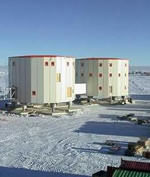
Image credit: ESA
Although a human mission to Mars is still years (maybe even decades) away, research is still being done to understand some of the challenges that will be faced on the six month journey to and from the Red Planet. Several space agencies (ESA, NASA, CNES) are seeking proposals from scientists to conduct research on the long-term effects of isolation in extreme environments at a new research station in Antarctica. Based on these proposals, several projects will be chosen to begin in Spring 2006.
A human mission to Mars may still be some time away, but scientists are already aware of the many hazards that must be overcome if the dream is to become a reality. One particular cause for concern is the potential for physiological and psychological problems that could arise from the conditions of weightlessness, isolation and confinement experienced during a journey that could last six months or more.
To address these concerns ESA, in cooperation with the French space agency CNES, NASA and two Antarctic research organisations, is seeking proposals from scientists wishing to participate in two pioneering ground-based studies to simulate some of the side effects of extended periods of space flight.
Concordia
The first of these Research Announcements is for opportunities to conduct medical, physiological and psychological research at the Concordia station, a new scientific base that is being built in Antarctica by IPEV – the French Polar Institute, and PNRA – the Italian Antarctic Programme.
The research will address potential problems that could arise during a human mission to Mars
Although proposals put forward under this Research Announcement may or may not be relevant to space exploration, the space agencies recognise that Concordia?s unique environment will be invaluable for preparatory activities related to future human Mars missions.
?As one of the most isolated places on Earth, Concordia will provide an excellent analogue environment to replicate aspects of a mission to Mars,? said study leader Oliver Angerer. ?For eight to nine months of the year the base will be completely cut off, so the occupants will have to learn to be fully autonomous.?
From the selected proposals, an integrated research programme will be created with a start date in spring 2006. The programme will be aimed at increasing knowledge of human adaptability to extreme environments – isolation, confinement, climate, altitude – and improving medical care in isolated locations.
International long-term bed rest study
In the second Research Announcement, ESA and the French Space Agency CNES are collaborating with NASA to solicit research proposals to address two of the cornerstones of the European Programme for Life and Physical Sciences and Applications utilising the International Space Station (ELIPS).
These are:
* Muscle and bone physiology: the effects of changes of load on muscles and bone mass
* Integrated physiology: the understanding of blood pressure and heart regulation
Transatlantic cooperation for this effort is welcome and NASA has issued an equivalent Research Announcement specifically for US investigators.
As opportunities for investigating human physiology in orbit are very limited, it is planned to simulate the effects of long-term microgravity on the ground by studying the human body’s response to head-down tilt bed rest over a period of 60-90 days. The study, which will take place at a specialised French bed rest facility of the Institute for Space Medicine (MEDES) in Toulouse, will also evaluate preventative strategies and countermeasures to combat the associated adverse effects.
Male astronauts and volunteers predominated during previous studies in simulated and real microgravity, so the planned study for 2004/05 will investigate about 25 female volunteers (intervention groups and control group) and, if scientifically justified, a male control group consisting of about seven volunteers. This should reveal the differences and similarities in the response of the female and male physiology to musculoskeletal unloading.
?Essential driving factors behind the two research studies are oriented towards both application and exploration,? explained study leader Peter Jost. ?In this way, the results will benefit the ESA Life Sciences Programme, with important spin-offs for medical science. Ultimately, advanced strategies will be developed to further improve health and safety during long-term stays on the International Space Station, and to facilitate a human mission to Mars.?
Original Source: ESA News Release
Mars Explorer Update
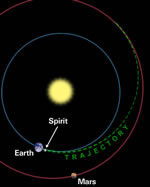
Image credit: NASA
Just 48 hours after launch, NASA’s Spirit spacecraft was 5.6 million kilometres away from Earth and on track for Mars. Just after launch, Spirit was rotating 12.03 times a minute and then thrusters on board reduced this to 2 rotations a minute. As the spin rate slowed down, the star scanners on Spirit were able to recognize various constellations and plot its position. The next hurdle will be when Spirit performs a trajectory-correction maneuver sometime soon. Spirit will arrive at Mars on January 4, 2004.
NASA’s Spirit spacecraft, the first of twin Mars Exploration Rovers, has successfully reduced its spin rate as planned and switched to celestial navigation using a star scanner.
All systems on the spacecraft are in good health. As of 48 hours after the June 10 launch, Spirit had traveled 5,630,000 kilometers (3,500,000 miles) and was at a distance of 610,000 kilometers (380,000 miles) from Earth.
After separation from the third stage of its Delta II launch vehicle on Tuesday, Spirit was spinning 12.03 rotations per minute. Onboard thrusters were used Wednesday to reduce the spin rate to approximately 2 rotations per minute, the designed rate for the cruise to Mars. After the spinning slowed, Spirit’s star scanner found stars that are being used as reference points for spacecraft attitude.
Navigators and other flight team members at NASA’s Jet Propulsion Laboratory, Pasadena, Calif., will be deciding soon when to perform the first of several trajectory-correction maneuvers planned during the seven-month trip between Earth and Mars.
Spirit will arrive at Mars on Jan. 4, 2004, Universal Time (evening of Jan. 3, 2004, Eastern and Pacific times). The rover will examine its landing area in Mars’ Gusev Crater for geological evidence about the history of water on Mars.
JPL, a division of the California Institute of Technology, manages the Mars Exploration Rover project for NASA’s Office of Space Science, Washington, D.C. Additional information about the project is available from JPL at http://mars.jpl.nasa.gov/mer and from Cornell University, Ithaca, N.Y., at http://athena.cornell.edu .
Original Source: NASA/JPL News Release
More Evidence that Meteors Caused Mass Extinctions
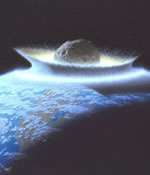
Image credit: NASA
A team of researchers from Louisiana State University have uncovered a connection between a meteor strike and a mass extinction that happened 380 million years ago called the middle Devonian event. It happened at a time when small plants, wingless insects and spiders inhabited the land, and everything else lived in the sea – 40% of all life disappeared from the fossil records. They found evidence of the strike by measuring the magnetic signature of layers of rock. When a large asteroid hits the Earth, it distributes a layer of dust around the entire planet – if a strata of rock has the same magnetic signature in different parts of planet, it’s evidence of a strike.
It’s the stuff of science fiction movies. Bruce Willis, by a mighty effort, saving the world from extinction by a huge meteor.
But Bruce Willis won’t do it, and in our current state of readiness, neither will anyone else. That is why LSU geophysicist Brooks Ellwood is plumbing the geologic record, trying to correlate known mass extinctions to meteor strikes.
“When we think about the human race and life in general, what do we worry about? We worry about nuclear holocaust and major glaciation. Then we worry about the giant chunks of rock that fly past Earth all the time,” Ellwood said.
“We can’t see them till they’re here, we can’t stop one, so the question is, how often do they hit the Earth and cause major mass extinctions? Are extinctions often caused by impacts? If so, we want to be sure we are prepared.”
Ellwood and four other researchers have just published an article in the journal Science in which they tie an early mass extinction to a meteor strike. This extinction happened 380 million years ago in what is called the middle Devonian. It was a time when only small plants, wingless insects and spiders inhabited the land and everything else lived in the sea. About 40 percent of all species disappeared from the fossil record at this time.
The extinction has been known to geologists for a long time but this is the first time it has been tied to a meteor strike. This is also the oldest known impact that has been tied to a mass extinction.
Ellwood is quick to point out that because the extinction and the meteor strike happened at the same time does not prove the impact caused the extinction — but it certainly suggests it.
One of the great difficulties in determining whether an extinction happened on a global scale, or was a local event caused by a volcano or some other terrestrial force, is identifying the same strata of rock at different locations on the globe. Finding a layer of earth in Colorado, for example, and finding that same layer in Australia is no simple task.
“The same layer of earth is exposed to different conditions in different parts of the world,” Ellwood said. “Weathering, upheavals, volcanos, earthquakes and flooding all confuse the geologic record, making it incomplete and open to interpretation.”
The layers can also be extremely thin, he said, showing a picture of the location of his latest research. The layer he was looking at — near the top of a barren plateau in the Anti Atlas desert near Rissani in Morocco — was about the thickness of a felt-tipped marker and only distinguishable from the soil around it by its reddish color.
What is unique about Ellwood’s work, however, is the means he uses to identify the different layers in the geologic record: induced magnetism.
“Everything is magnetic,” he said. “If I put your finger in a magnetic coil and turn it on, your finger will be magnetized.” Ellwood uses this phenomenon to take “magnetic signatures” of geologic samples. The magnetic signature of a layer of earth will be the same anywhere in the world, making it relatively easy to identify strata, if they can be found. These signatures also make it easy to identify meteor strikes. “The magnetic pattern associated with an impact layer is often distinctive, making it easier to find in a thick sequence of strata,” he said.
Working with LSU graduate students Steve Benoist and Chris Wheeler; structural geologist Ahmed El Hassani of the University of Rabat, Morocco; and Devonian biostratigrapher Rex Crick of the University of Texas at Arlington, Ellwood was able to find high concentrations of shocked quartz, microscopic spherules and microcrysts in this layer, sure signs of a meteor impact. Benoist is a paleontologist and Wheeler is an isotope geochemist; both have since moved on.
The past 550 million years are divided up by geologists into about 90 “stages.” Each stage is distinguished from another by a change in the fossil record. To date, only four of these stages show strong evidence of a meteor strike, Ellwood’s discovery being the latest, as well as the oldest. The most recent, best known extinction is the K-T boundary at which the dinosaurs died out, about 65 million years ago. There have been five major mass extinctions and many smaller ones since then.
“We know that meteors have struck the Earth hundreds of times,” Ellwood said. “If I had to guess, I would say that once every 5 million years a meteor big enough to cause a mass extinction hits the Earth.
“We could protect ourselves if we wanted. We went to the moon, we can figure out how to destroy or deflect a meteor. All it takes is the political will — and an awareness of the threat.”
The work of Ellwood and his team, published in the prestigious journal Science, is a step in that direction.
Original Source: LSU News Release
Where’s Spirit Now?
Just a few extra notes for today:
NASA has made a Mars Explorer tracking page available on its website. Every few minutes or so, a series of images are updated that show how far along the spacecraft has gotten on its journey; the view of Mars; view of Earth, etc. Pretty cool. Check it out here.. I guess they’ll do another for “Opportunity” when it launches.
A big congratulations to Abbotsford and Calgary for winning Canada’s light pollution abatement awards. Both cities have made huge advances towards reducing obnoxious glare in the night sky (and reduced their pollution and energy use). Nice going.
Finally, there’s a free lecture at 7:00 pm PDT tonight at NASA/JPL about the Space Infrared Telescope Facility. If you’re interested in the “last of the great observatories”, you can stop by and listen in. Here’s more information. They’ll also be webcasting the presentation live on the Internet.
Investigators Find Another Potential Shuttle Problem
Shuttle investigators have found another potential problem that could damage future space shuttles during launch. When searching through radar data of the Columbia, the investigation board discovered that an 18 kilogram bolt connecting the shuttles boosters to its fuel tank flew off . There’s no evidence that it actually hit the shuttle, but its potential damage to future missions could be catastrophic. Fragments of the bolt are supposed to be caught in a special cylinder to prevent exactly this kind of problem, but it appears that the capture device needs improvements.
Ariane 5 Launches Two Satellites
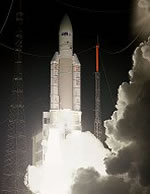
Image credit: Arianespace
An Ariane 5 rocket successfully launched two geostationary communications satellites Wednesday evening after an hour’s delays because of poor weather. The Ariane 5G lifted off at 2238 GMT (6:38 pm EDT) and the two satellites separated 35 minutes later. The first satellite is the Australian commercial/military Optus and Defence C1 communications satellite which will provide coverage for the Asia Pacific region. The other is the Japanese BSAT-2c which will provide satellite television services throughout Japan.
Kourou, French Guiana, June 11, 2003 – Arianespace today orbited two geostationary communications satellites: Optus and Defence C1 for the Australian operator Optus and the Australian Department of Defence, and BSAT-2c for the Broadcasting Satellite System Corporation (B-SAT) of Japan under terms of a turnkey contract with Orbital Sciences Corporation of the United States.
Twelfth successful launch
With its 12th successful mission, the Ariane 5 Generic launcher confirmed its technical and operational maturity.
This latest success comes two months after the previous Ariane 5 flight — which also orbited a dual-satellite payload, and less than 10 days after Starsem’s successful Soyuz commercial mission with the European Space Agency’s Mars Express spacecraft.
Several days prior to launch, a ministerial-level ESA Council meeting authorized the Ariane 5 support plan and approved construction of a Soyuz launch pad at the Guiana Space Center, Europe’s Spaceport. These decisions give Arianespace the means to operate a full range of launch vehicles that respond to all client requirements.
Prestigious customers: Australia, Japan and the United States
The choice of Ariane by major space telecom manufacturers and operators in the United States, Japan and Australia clearly reflects international recognition of Arianespace’s top-flight launch service.
Optus and Defence C1 is the second Australian satellite to be launched by Ariane. In September 1987, Ariane orbited the Aussat K3 satellite, while Singtel — the parent company of operator Optus — had its ST-1 spacecraft launch by Ariane in 1998.
BSAT-2c is the 19 satellite launched by Ariane for Japan, and the fifth for telecom operator B-SAT — following BSAT-1a on Flight 95, BSAT-1b on Flight 108, and BSAT-2a and BSAT-2b on Flights 140 and 142. BSAT-2C is the fifth satellite built by Orbital Sciences Corporation to be launched by Arianespace using an Ariane 5 since March 2001.
Flight 161 at a glance
Flight 161 was carried out by an Ariane 5 Generic launcher from Europe’s Spaceport in Kourou, French Guiana. Liftoff was on Wednesday, June 11, 2003 at 7:38 p.m. local time in Kourou (22H38 GMT, 6:38 p.m. in Washington, D.C., 12:38 am in Paris on June 12, and at 7:38 am in Tokyo and 8:38 am in Sydney on June 12).
Provisional parameters at injection of the storable propellant upper stage were:
Perigee: 590 km for a target of 590 km (?3 km)
Apogee: 35,798 km for a target of 35,826 km (?160 km)
Inclination: 7.00 degrees for a target of 6.99 degrees (?0.06?)
Optus and Defence C1: Mitsubishi Electric Corporation of Japan is the prime contractor, and is responsible for all communications systems. Space Systems Loral of the United States designed, assembled and integrated the bus and satellite system.
Weighing about 4,725 kg at liftoff, it will be positioned at 156 degrees East. Equipped with 24 Ku-band transponders, it will provide commercial communications services for Australia, New Zealand, Southeast Asia and Hawaii. It also carries 4 X-band transponders, 4 Ku-band transponders and 6 UHF channels to provide dedicated links for the Australian Department of Defence.
Built by Orbital Sciences Corporation in Dulles, Virginia using the Star-1 platform, BSAT-2c weighed 1,275 kg at liftoff. It will be positioned at 110 degrees East. Equipped with 4 Ku-band transponders, it will provide direct TV broadcast services throughout Japan over its design life of 10 years. Over 16 million households receive programs broadcast by the B-SAT satellite.
Original Source: Arianespace News Release
New Evidence for Cold Dark Matter
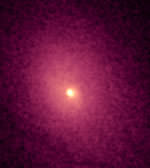
Image credit: Chandra
A new image taken by the Chandra X-ray observatory is helping astronomers to understand the composition of dark matter in the Universe. Abell 2029 is composed of thousands of galaxies enveloped in a cloud of hot gas – and a mass of dark matter equal to a hundred trillion Suns. The X-ray data shows that the density of the dark matter increases smoothly all the way to the centre of the galaxy, which matches predictions of the “cold dark matter” model. This model gets its name from the assumption that the dark matter particles were moving slowly when galaxies first formed, and interact with normal matter only through gravity.
Astronomers have used NASA’s Chandra X-ray Observatory to make the most detailed probe yet of the distribution of dark matter in a massive cluster of galaxies. Their results indicate that about 80 percent of the matter in the universe consists of cold dark matter – mysterious subatomic particles left over from the dense early universe.
Chandra observed a cluster of galaxies called Abell 2029 located about a billion light years from Earth. The cluster is composed of thousands of galaxies enveloped in a gigantic cloud of hot gas, and an amount of dark matter equivalent to more than a hundred trillion Suns. At the center of this cluster is an enormous, elliptically shaped galaxy that is thought to have been formed from the mergers of many smaller galaxies. The X-ray data show that the density of dark matter increases smoothly all the way into the central galaxy of the cluster. This discovery agrees with the predictions of cold dark matter models, and is contrary to other dark matter models that predict a leveling off of the amount of dark matter in the center of the cluster.
“I was really surprised at how well we could measure the dark matter so deep into the core of a rich cluster,” said Aaron Lewis of the University of California, Irvine, lead author of a paper describing the results in a recent issue of The Astrophysical Journal. “We still have very little idea as to the exact nature of these particles, but our results show that they must behave like cold dark matter.”
Cold dark matter gets its name from the assumption that the dark matter particles were moving slowly when galaxies and galaxy clusters began to form. Dark matter particles interact with each other and “normal” matter only through gravity.
The astronomers’ success in placing such tight constraints on the dark matter distribution was partly due to Chandra’s ability to make a high resolution intensity and temperature map, and partly due to their choice of a target. The cluster and central galaxy are unusually regular, with little or no sign of disturbance.
The hot gas in a cluster is held in the cluster primarily by the gravity of the dark matter, so the distribution of the hot gas is determined by that of the dark matter. By precisely measuring the distribution of X-rays from the hot gas, the astronomers were able to make the best measurement yet of the distribution of dark matter in the inner region of a galaxy cluster.
“While Abell 2029 might be boring for the average person to look at,” said David Buote, a coauthor of the paper, “it is a pure delight for astrophysicists to study, because it allows for a very straightforward and accurate comparison of theory and observation.”
As a case in point, earlier observations of the Hydra A galaxy cluster by Larry David of the Harvard-Smithsonian Center for Astrophysics in Cambridge, Mass. and colleagues found a similar result but the evidence of explosive activity in the central galaxy made it difficult to draw definite conclusions about the nature of the dark matter. The dark matter profile deduced for Abell 2029 provides evidence that the Hydra results are reliable and is an important independent confirmation of cold dark matter predictions.
John Stocke of the University of Colorado, Boulder was also involved in this research. Chandra observed Abell 2029 with the ACIS detector for 5.6 hours on April 12, 2000. NASA’s Marshall Space Flight Center, Huntsville, Ala., manages the Chandra program for the Office of Space Science, NASA Headquarters, Washington. Northrop Grumman of Redondo Beach, Calif., formerly TRW, Inc., was the prime development contractor for the observatory. The Smithsonian Astrophysical Observatory controls science and flight operations from the Chandra X-ray Center in Cambridge, Mass.
Original Source: Chandra News Release
Shuttle May Fly After Extreme Inspections
NASA is indicating that a new regime of inspections will be required for its fleet of space shuttle to start flying again. In the case of Columbia, it’s believed that a hairline crack only a few centimeters long was created when a chunk of foam from its fuel tank smashed into its wing. NASA administrator Sean O’Keefe said that it’s going to take an “extremely meticulous” inspection system to catch this kind of problem for future flights. When launches do resume, they will be daytime flights only, so cameras can monitor the shuttle’s flight to orbit. The shuttle may return to flight in December or some time in 2004.
